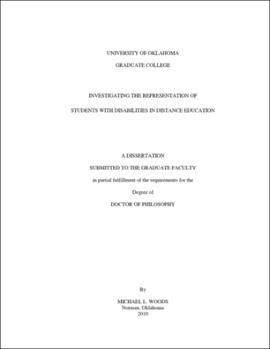| dc.contributor.advisor | Maiden, Jeffery | |
| dc.creator | Woods, Michael Landon | |
| dc.date.accessioned | 2019-04-27T21:24:09Z | |
| dc.date.available | 2019-04-27T21:24:09Z | |
| dc.date.issued | 2010 | |
| dc.identifier | 99159957202042 | |
| dc.identifier.uri | https://hdl.handle.net/11244/318598 | |
| dc.description.abstract | The primary purpose of this study was to determine the representation of students with disabilities participating in distance education courses. Corollary research questions investigated perceptions, beliefs and expectations of secondary school principals and special education teachers, and determine the existence of statistically significant differences in efficacy of secondary school principals and special education teachers related to location and size of the school site. | |
| dc.description.abstract | A secondary school principal survey and a special education teacher survey were mailed to 469 secondary school sites identified by the Oklahoma Secondary School Activity Association classification methods. Surveys identified schools by size and location with ten questions designed to gain insight to the perceptions, beliefs and expectations of secondary school principals and secondary school principals. Secondary school principals provided additional school site information related to school enrollment and special education enrollment based on the First Quarter Statistical Report required by the Oklahoma State Department of Education. | |
| dc.description.abstract | Data were statistically measured by descriptive statistics, two-tailed independent t-tests, and two-factor Analysis of Variance. Bonferroni correction was used to ensure a Type I error was not created by multiple comparisons. With a p<.005, outcomes indicate no statistically significant difference in the percentage of students with disabilities participating in distance education courses and the general education population participating in distance education. Secondary school principals and special education teachers responses indicated areas of agreement in their perceptions, beliefs and expectations of students with disabilities enrolling in distance education. No statistically significant difference exists related to secondary school site location or size. | |
| dc.format.extent | 244 pages | |
| dc.format.medium | application.pdf | |
| dc.language | en_US | |
| dc.relation.requires | Adobe Acrobat Reader | |
| dc.subject | Distance education--Oklahoma | |
| dc.subject | Teenagers with disabilities--Education--Oklahoma | |
| dc.subject | Distance education--Oklahoma--Public opinion | |
| dc.subject | High school principals--Oklahoma--Attitudes | |
| dc.subject | Teachers of children with disabilities--Oklahoma--Attitudes | |
| dc.subject | Public opinion--Oklahom | |
| dc.title | INVESTIGATING THE REPRESENTATION OF STUDENTS WITH DISABILITIES IN DISTANCE EDUCATION | |
| dc.type | text | |
| dc.type | document | |
| dc.thesis.degree | Ph.D. | |
| ou.group | Jeannine Rainbolt College of Education::Department of Educational Leadership and Policy Studies | |
